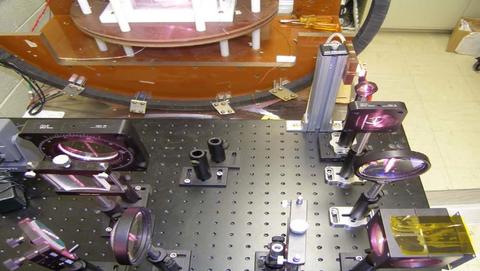SEOP METHOD
Spin Exchange Optical Pumping (SEOP)

In the spin-exchange method (apparatus shown above), two steps are needed to polarize 3He by this method: polarization of the rubidium (Rb)/potassium (K), and spin exchange between the Rb/K and the 3He nucleus. An optically thick vapor (1014 to 1015 cm−3) of Rb/K is generated by heating a cell filled with 3He, typically 70 mbar of N2, and a small amount of Rb/K metal. The electronic spin of the Rb/K is polarized by optical pumping with near infrared laser light. A simplified two-level pumping scheme (which ignores the nuclear spin of the rubidium) is shown in Fig. 2. circularly polarized (σ+) light excites only atoms in the mj = -1/2 state. Atoms that decay to the mj = +1/2 state remain in that state, but atoms that decay mj = -1/2 state are re-excited by the laser. The nitrogen in the cell suppresses emission of photons, which depolarize other atoms. During binary collisions between the Rb/K atoms and the 3He nucleus, the hyperfine interaction between the unpaired Rb/K electron and the 3He nucleus can transfer spin. This is a slow process, resulting in long time constants (typically from several hours to a few tens of hours) for polarizing 3He, but the time constant is independent of the 3He density. The temporal evolution of the polarization is given by
$$ P_{\mathrm{He}}(t) = P_A \left (\frac{\gamma_{\mathrm{se}}}{\Gamma_{\mathrm{He}}}\right) \left [1 - e^{-\Gamma_{\mathrm{He}}t}\right] \tag{1}$$
where \(P_{\mathrm{He}}\) is the 3He polarization, \(\gamma_{\mathrm{se}}\) is the spin exchange rate (proportional to Rb vapor density), \(P_{\mathrm{A}}\) is the alkali polarization, and \(\Gamma_{\mathrm{He}}\) is the 3He spin relaxation rate and is given by
$$ \Gamma_{\mathrm{He}} = \frac{1}{T_{\mathrm{1}}} + (1 + X){\gamma_{\mathrm{se}}} \tag{2}$$
here \(T_{\mathrm{1}}\) is the relaxation time of 3He spin at room temperature. \(X\) is a phenomenological parameter that reflects the recent observation that the slope of the 3He spin relaxation rate with alkali density exceeds the spin-exchange rate. This phenomenon, an "excess" relaxation that scales with alkali density, was recently discovered at the Univ. of Wisconsin {Chann02}, and has been recently studied at Wisconsin and NIST {Chann03 , Gentile05 , Babcock}.
The above equation (1) describes polarization asymptotically, approaching the limiting value \(P_A \left (\frac{\gamma_{\mathrm{se}}}{He}\right)\) with a pump-up time constant of \(\frac{1}{\Gamma_{\mathrm{He}}}\). Typical values of \(\frac{1}{\gamma_{\mathrm{se}}}\) and \(T_{\mathrm{1}}\) are 5 to 20 hours and 50 to 500 hours, respectively. With sufficient laser power and long lifetime cells, it is possible for \(P_{\mathrm{A}}\) to approach unity and for \(\frac{1}{T_{\mathrm{1}}}\) to be a small correction. In this case, \(P_{\mathrm{He}}\) can approach \(\frac{1}{1 + X}\). Until recently it was thought that \(X\) would be near zero, but the relaxation studies at Wisconsin first revealed a value of 0.33, which yields a polarization limit of 75%. More extensive studies at Wisconsin and NIST have now shown that \(X\) varies from cell to cell, in a range between 0.15 and 1. For most of the larger spin filter cells that we have employed, \(X\) is 0.25 to 0.3 {Babcock}. Improving the maximum achievable 3He polarization in SEOP requires us to eliminate or reduce the temperature-dependent relaxation that is the origin of the current limit.
| Diagram of SEOP Station | Optical Pumping Background | NSF Figure of Merit |
Contacts
-
(301) 975-6222
-
(301) 975-6232

